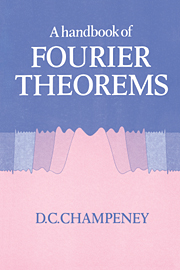Book contents
- Frontmatter
- Contents
- Preface
- 1 Introduction
- 2 Lebesgue integration
- 3 Some useful theorems
- 4 Convergence of sequences of functions
- 5 Local averages and convolution kernels
- 6 Some general remarks on Fourier transformation
- 7 Fourier theorems for good functions
- 8 Fourier theorems in Lp
- 9 Fourier theorems for functions outside Lp
- 10 Miscellaneous theorems
- 11 Power spectra and Wiener's theorems
- 12 Generalized functions
- 13 Fourier transformation of generalized functions I
- 14 Fourier transformation of generalized functions II
- 15 Fourier series
- 16 Generalized Fourier series
- Bibliography
- Index
2 - Lebesgue integration
Published online by Cambridge University Press: 05 June 2012
- Frontmatter
- Contents
- Preface
- 1 Introduction
- 2 Lebesgue integration
- 3 Some useful theorems
- 4 Convergence of sequences of functions
- 5 Local averages and convolution kernels
- 6 Some general remarks on Fourier transformation
- 7 Fourier theorems for good functions
- 8 Fourier theorems in Lp
- 9 Fourier theorems for functions outside Lp
- 10 Miscellaneous theorems
- 11 Power spectra and Wiener's theorems
- 12 Generalized functions
- 13 Fourier transformation of generalized functions I
- 14 Fourier transformation of generalized functions II
- 15 Fourier series
- 16 Generalized Fourier series
- Bibliography
- Index
Summary
Introduction
Early developments of Fourier theory were based on the theory of integration of G. F. B. Riemann (1826–66). However, an alternative approach to integration developed by H.L. Lebesgue (1875–1941) turns out to be more powerful and simpler to use so far as Fourier theory is concerned, and virtually all modern mathematical approaches are based on Lebesgue's theory. Whilst a full understanding of Lebesgue's theory is not necessary in later chapters, some familiarity with the ideas is essential, and the following description is intended for a reader who is familiar with Riemann but not Lebesgue integration.
Riemann integration
The procedure for defining the proper Riemann integral of some single valued, real function of a real variable between the finite limits a and b may be visualized by dividing the area under the graph of the function into vertical strips. The area of each strip is approximated to the product of the width of the strip and the sampled value of the function at some arbitrary point within the strip, and one considers the limit of the sum of these approximate areas as the widths of the strips tend to zero and the number of such strips tends to infinity.
A rigorous treatment, as in Apostol (1974) for instance, considers whether the limit so obtained depends upon the particular way the strips or the sample values are chosen at each stage of the limiting process.
- Type
- Chapter
- Information
- A Handbook of Fourier Theorems , pp. 4 - 14Publisher: Cambridge University PressPrint publication year: 1987



